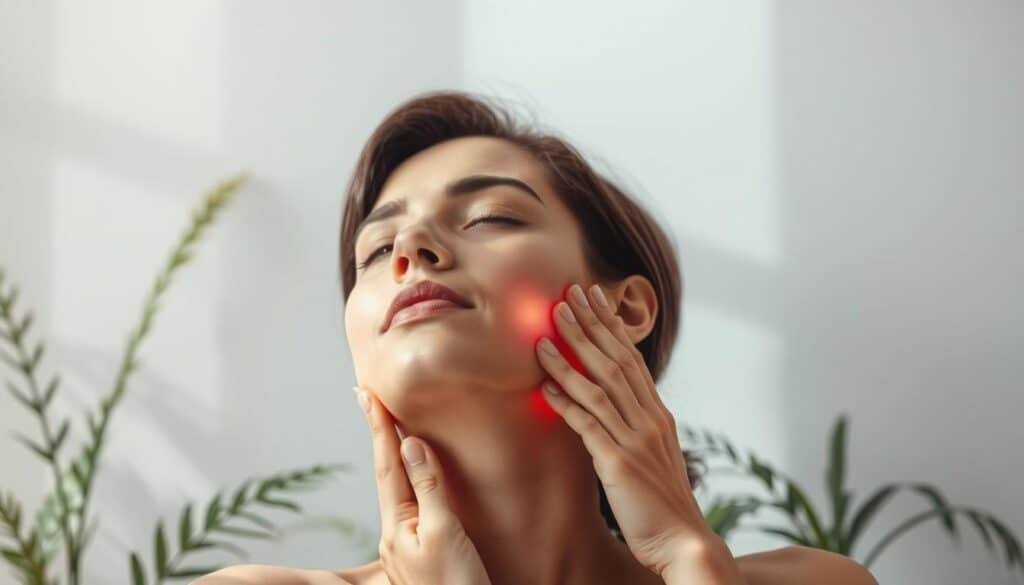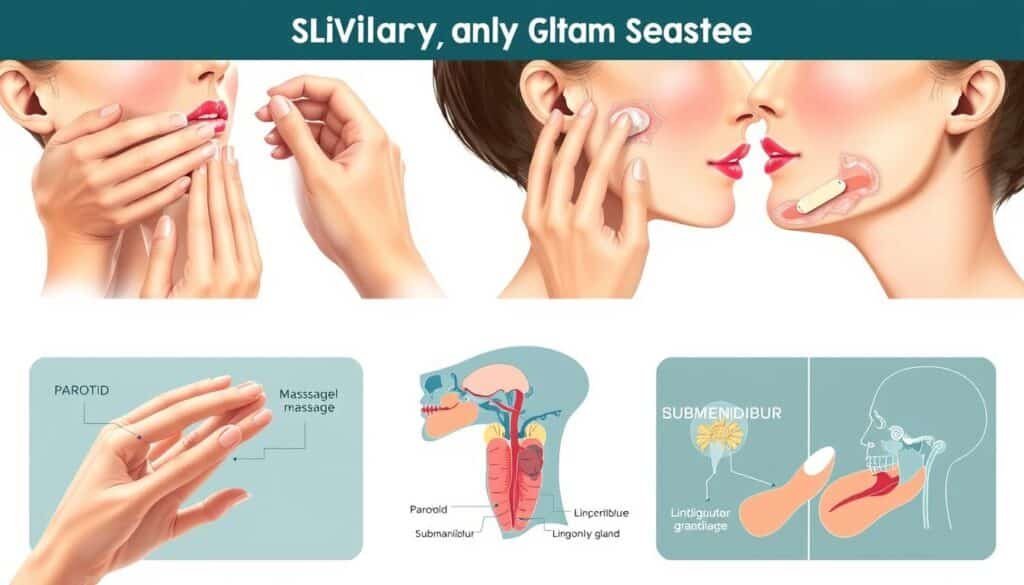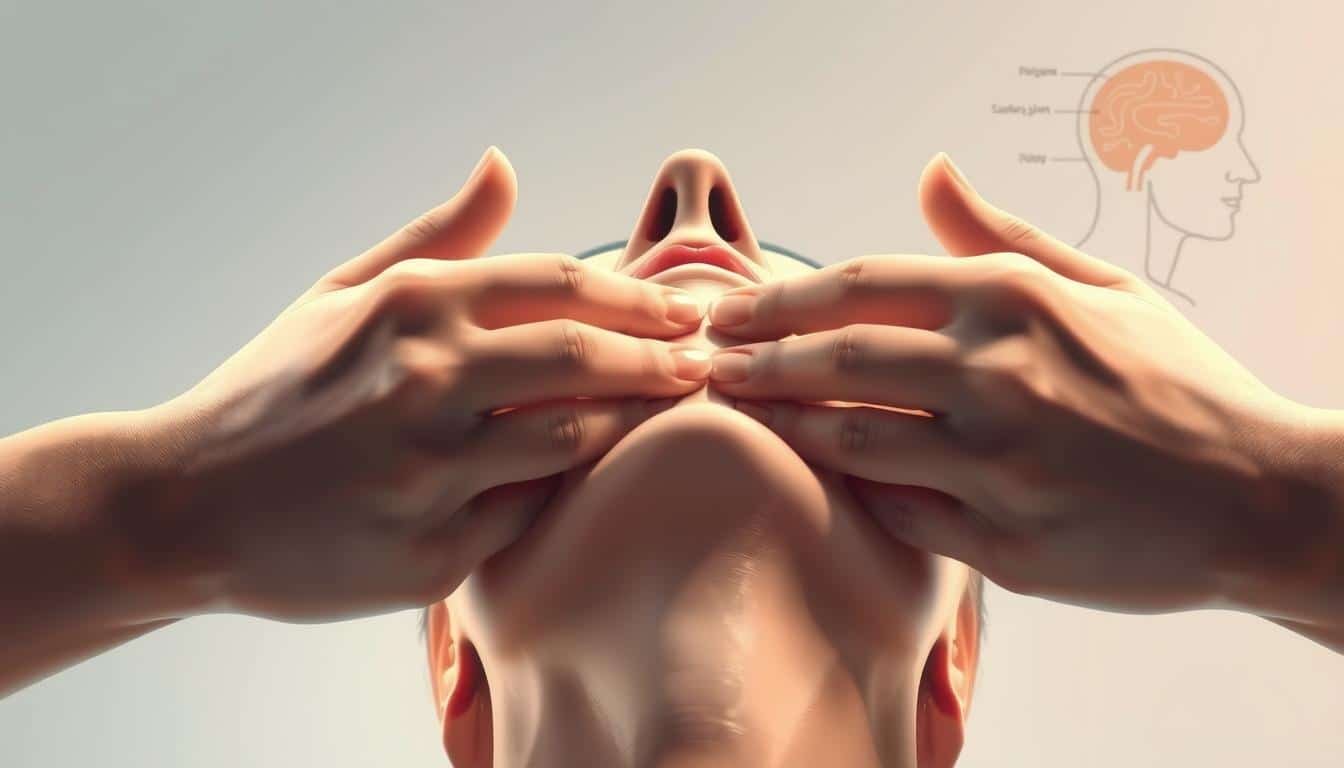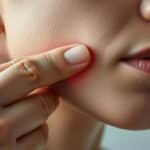Ever thought about boosting your oral health at home? Salivary gland massage might be the key. It’s simple and can help with mouth issues. I’m here to teach you how to do it right.
This guide will show you how to massage your glands. We’ll focus on the parotid, submandibular, and sublingual glands. Doing these massages daily can help keep your mouth healthy and reduce dry mouth discomfort.
Whether you have dry mouth sometimes or want better oral health, gland massage can help. Let’s explore how these easy techniques can change your daily life for the better.
Key Takeaways
- Salivary gland massage can improve oral health and saliva production
- The technique targets parotid, submandibular, and sublingual glands
- Regular massages may help alleviate dry mouth symptoms
- Proper technique and hygiene are crucial for effective massage
- Incorporating gland massage into daily routines can boost oral care
Understanding Salivary Glands and Their Function
I’ve always been fascinated by how our bodies work, especially our mouths. Let’s explore the role of salivary glands in keeping our mouths healthy.
What are salivary glands?
Salivary glands are small organs in our mouths that make saliva. The main ones are the parotid, submandibular, and sublingual glands. They work hard to keep our mouths moist and working right.
The role of saliva in oral health
Saliva does more than just keep our mouths wet. It’s crucial for oral health. It breaks down food, cleans away bacteria, and strengthens our teeth. Without enough saliva, our oral hygiene would suffer greatly.
- Aids in digestion
- Maintains oral pH balance
- Protects against harmful bacteria
- Helps prevent tooth decay
Common issues affecting salivary glands
Our salivary glands can sometimes have problems. Issues like stones or less saliva can happen. Dry mouth is common and can cause discomfort and harm our oral health. Knowing about these problems helps us take better care of our mouths.
“A healthy mouth is the gateway to a healthy body. Take care of your salivary glands, and they’ll take care of you.”
Understanding how salivary glands work is key to good oral health. By following good oral hygiene tips and using dry mouth remedies, we can keep our glands healthy. This keeps our smiles bright.
Benefits of Salivary Gland Massage

Salivary gland massage is a game-changer for those seeking natural remedies for dry mouth. I’ve found this simple technique incredibly effective in improving salivary flow. It’s not just about comfort; it’s about maintaining oral health.
Massaging these glands stimulates saliva production, which is crucial for keeping our mouths moist and healthy. For those dealing with xerostomia, this massage can be a lifesaver. It’s a non-invasive xerostomia treatment that anyone can do at home.
One of the most significant benefits I’ve noticed is the potential relief from salivary gland stones. Regular massage can help prevent stone formation and even aid in their removal. It’s like giving your mouth a mini-workout!
- Boosts natural saliva production
- Helps alleviate dry mouth symptoms
- May assist in preventing salivary stones
- Enhances overall oral hygiene
By incorporating this massage into my daily routine, I’ve experienced improved oral comfort and freshness. It’s become an essential part of my oral care, complementing brushing and flossing. For anyone looking to enhance their oral health naturally, salivary gland massage is a simple yet powerful tool.
Preparing for Salivary Gland Massage
Before starting salivary gland massage, it’s important to get ready. I’ll show you how to prepare for a successful massage. This will help you enjoy the benefits fully.
Creating a Comfortable Environment
Look for a quiet spot where you can relax. Good lighting is important to see the glands clearly. I like using a bathroom with a big mirror for this.
Proper Hand Hygiene
Clean hands are crucial for salivary gland massage. Wash your hands well with soap and warm water for 20 seconds. This keeps your mouth safe from harmful bacteria.
Positioning Yourself for Massage
Find a comfy spot to access your face and neck. Standing or sitting in front of a mirror is best. It helps you see where your hands are and target the right spots.
Before you start, warm up your hands by rubbing them together. This makes the massage more comfortable and effective. With these steps done, you’re all set for your salivary gland massage.
How to Massage Saliva Glands: Step-by-Step Guide
Learning to massage your saliva glands can boost your oral health. I’ll show you how to find and massage each major gland. This easy method can help increase saliva and ease pain.
Locating the Major Salivary Glands
First, know where your salivary glands are. The parotid glands sit in front of your ears. The submandibular glands are under your jaw. And the sublingual glands are under your tongue.
Parotid Gland Massage Technique
To massage your parotid glands, use your fingertips. Make gentle circular motions in front of your ears. Start at the top and move down to your jaw. This helps get your saliva flowing.
Submandibular Gland Massage Technique
For the submandibular glands, put your fingers under your jaw. Use light pressure and move your fingers up towards your chin. This can clear any blockages in these glands.
Sublingual Gland Massage Technique
To massage your sublingual glands, press gently under your tongue with your fingertip. Use a circular motion to stimulate these glands. Be gentle, as this area is sensitive.
Do each of these massages for 30 to 60 seconds. With regular practice, you’ll find it easy to add these massages to your daily routine. This will help improve your oral health.
Frequency and Duration of Salivary Gland Massage

Salivary gland massage is important for better saliva flow. I suggest doing these massages 2-3 times a day. Each massage should last 5-10 minutes to cover all major glands.
Being consistent with salivary gland massage is key. A regular routine leads to better saliva flow over time. Here’s a suggested schedule:
- Morning: Before or after breakfast
- Afternoon: After lunch
- Evening: Before bedtime
Keep in mind, everyone’s needs vary. You might need to change how often you massage based on your situation. If you have severe dry mouth or other gland issues, more massages could help.
| Condition | Recommended Frequency | Duration per Session |
|---|---|---|
| Mild dry mouth | 2 times daily | 5 minutes |
| Moderate dry mouth | 3 times daily | 7 minutes |
| Severe dry mouth | 4 times daily | 10 minutes |
For advice on improving saliva flow through massage, talk to a healthcare professional. They can create a plan that suits your needs and lifestyle.
Complementary Techniques to Boost Saliva Production

Salivary gland massage is just one way to combat dry mouth. I’ve found other effective ways to boost saliva production. Let’s look at some practical remedies and oral hygiene tips to keep your mouth fresh and comfortable.
Hydration Tips
Staying hydrated is key for saliva production. I drink water all day. I keep a reusable water bottle with me to remind me to drink often. I also add cucumber slices or mint leaves to my water for flavor.
Dietary Considerations
Some foods can naturally stimulate saliva flow. I add these foods to my diet:
- Citrus fruits (oranges, lemons)
- Crunchy vegetables (carrots, celery)
- Sugar-free gum or candies
Oral Exercises
Simple exercises can help stimulate salivary glands. I do these exercises all day:
| Exercise | Description | Frequency |
|---|---|---|
| Tongue Rolls | Roll tongue from side to side | 10 times, 3x daily |
| Lip Stretches | Stretch lips wide, then pucker | 5 repetitions, 2x daily |
| Cheek Massage | Gently massage cheeks in circular motions | 30 seconds, 4x daily |
By using these techniques with salivary gland massage, I’ve seen big improvements. Remember, being consistent is important when using these saliva boosters and oral hygiene tips.
Precautions and Contraindications
When thinking about salivary gland massage for dry mouth, I must be careful. Safety is key in any health practice.
I don’t massage if I have an active mouth or neck infection. Open sores are a big no. If it hurts or feels wrong, I stop right away.
My health history is important for deciding if massage is good for me. I talk to my doctor first if I have:
- A history of oral cancer
- Had radiation to the head and neck
- Other health issues with my salivary glands
Salivary gland massage can help with dry mouth, but it’s not for everyone. I always listen to my doctor’s advice more than my own.
| Condition | Safe to Massage? | Action |
|---|---|---|
| Active oral infection | No | Seek medical treatment first |
| Inflammation in mouth/neck | No | Wait until resolved |
| Open sores | No | Allow to heal completely |
| Pain during massage | No | Stop and consult doctor |
| History of oral cancer | Consult doctor | Follow professional advice |
By being careful, I make sure my salivary gland massage is safe and works for dry mouth symptoms.
Incorporating Salivary Gland Massage into Your Daily Routine
Adding salivary gland massage to your daily routine can boost your oral health. It’s easier to remember and more effective when you do it with your usual oral care. This makes it a simple habit to keep up.
Morning and evening rituals
I start my day with a quick salivary gland massage. It only takes a few minutes and boosts saliva production for the day. At night, I do it again to keep saliva flowing while I sleep. It’s as routine as brushing my teeth.
Combining with oral hygiene practices
Adding salivary gland massage to my oral care has changed the game. I’ve learned to massage my saliva glands well while following these tips:
- Brush teeth thoroughly
- Floss between all teeth
- Use an alcohol-free mouthwash
- Perform salivary gland massage
- Check for any oral abnormalities
By mixing these steps, I get full oral care. The massage is the last step, boosting saliva and cleaning out leftovers. It’s a simple addition that has greatly enhanced my oral health routine.
| Time of Day | Oral Care Steps | Duration |
|---|---|---|
| Morning | Brush, Floss, Massage | 5-7 minutes |
| Evening | Brush, Floss, Mouthwash, Massage | 7-10 minutes |
Troubleshooting Common Issues During Massage
When you try salivary gland massage, you might face some problems. Let’s look at how to solve these issues and make your experience better.
Dealing with discomfort
If you feel pain during the massage, it’s okay. It’s crucial to listen to your body. Try reducing the pressure or how often you massage.
Start with softer motions and slowly add more pressure as you get used to it. If the pain doesn’t go away, talk to a healthcare expert for advice.
Adjusting pressure and technique
Getting better at salivary flow takes time and practice. Try different pressures and movements to see what works for you. Use slower, circular strokes if fast ones hurt.
Remember, being patient is important when learning salivary gland massage techniques.
Watch for any unusual swelling, tenderness, or changes in your saliva. If you see these signs, contact your dentist or doctor right away. They can help you stay on track with improving your oral health through massages.
FAQ
What are salivary glands and what is their role?
What are the benefits of salivary gland massage?
How do I locate the major salivary glands?
How often should I perform salivary gland massage?
Are there any precautions or contraindications for salivary gland massage?
How can I incorporate salivary gland massage into my daily routine?
What should I do if I experience discomfort during salivary gland massage?
Source Links
- Salivary Gland Stone: Care Instructions – https://myhealth.alberta.ca/Health/aftercareinformation/pages/conditions.aspx?hwid=abq9474
- How to do self-lymphatic massage on your head and neck – https://www.wsh.nhs.uk/CMS-Documents/Patient-leaflets/Lymphoedema/6660-1-How-to-do-self-lymphatic-massage-on-your-head-and-neck.pdf
- How to do Lymphatic Self-Massage on Your Face, Head and Neck – https://www.uhn.ca/PatientsFamilies/Health_Information/Health_Topics/Documents/Do_Lymphatic_Self-massage_Face_Head_Neck.pdf













4 Comments
Interesting read, but is massaging saliva glands really necessary? Cant our bodies naturally handle their function without intervention? Random thought.
Interesting read, but isnt it odd how we often overlook salivas crucial role for our oral health? Lets appreciate our glands more!
Absolutely! More spit appreciation needed. Its the unsung hero of oral hygiene!
Interesting read, but isnt there a risk of injuring your salivary glands if you massage them incorrectly? Just asking.